HOW TO MAKE A GOLD CUBAN LINK CHAIN
Since we released our YouTube video demonstrating how gold Cuban link chains are made (see above), it has gone viral and become our best performer since our channel was launched back in 2013 (to buy your next Cuban gold chain, click here)!
Why did we release this video? It’s really quite simple…we wanted to show our customers how much work goes into the making of a quality Cuban chain (at least 10 hours total for the 1-kilo chain on the video) and the skilled craftsmanship that’s involved.
On this particular video, the gold chain does not include a box clasp. This is because the particular client who ordered this chain preferred a continuous design. Nevertheless, a lot of clients order their chains with a clasp (which means that the weight of the clasp has to be accounted for when the chain is made). It’s simply a matter of preference.
NOTE: The Cuban links we make, also known as “Miami Cuban links,” use flattened type links. This is achieved during the filing process that we discuss below and it doesn’t mean that gold is removed or wasted during this procedure. On the contrary, the powdered gold that you see being filed away is collected to make other chains later. After filing, the chain will meet the desired specifications in terms of weight and quantity of gold (approximately 1000 grams on this video). Here’s a summary breaking down the major steps involved in the making of a 14K yellow gold 1-kilogram Cuban link chain that’s 30-inches long and 22-millimeters wide.
Mixing the Gold with Other Stuff!
“What other stuff?”…you may ask. After reading through some of the comments on our how-to video above, we realized that many people are a bit misinformed when it comes gold chains. Some of the comments complained that the chain was not really “gold” because it had a mix of other metals in it. This little lesson should clear this up…
Gold goes by a karat-scale. A karat (when used to refer to gold) is a unit of purity that represents how many parts of gold (out of a total of 24) are in a piece of gold jewelry. That is why “pure” gold is referred to as 24K gold; that is, 24 out of 24 parts in it are gold!
When making Cuban link chains or other gold jewelry, 24K gold is just not practical to use because it’s too soft and gets easily scratched up and damaged over time, even with regular wear! That is why other metals are alloyed (or mixed in) with the gold. These metals make the jewelry stronger and longer lasting. The chain showcased on the video above is a 14K-chain, meaning that it’s approximately 14 out of 24 parts gold (58.33% gold) and 10 parts other metals. The most common gold jewelry in the United States is 14-karats, but this varies for other countries.
When the melted gold is molded into a the bar near the beginning of the the video and the bar is scanned (with the funky, yellow XRF analyzer gun), the reading shows traces of gold (Au 58.78%), silver (Ag 6.95%), zinc (Zn 6.92%) and copper (Cu 27.35%). You can also notice these different materials by their color as the pellets are being poured onto the scale when the video starts.

Mixing in pure (24K) gold and other metals to make 14K gold.

Analysis of metals (Au, Ag, Zn, and Cu) in gold mixture using Niton XL2 XRF Analyzer.
Melting and Pouring the Gold
After the amount of 24K gold required is combined with the other necessary metals, the mixture is melted with a propane torch (click here to go to that section of the video). The gold is then poured into a cast iron ingot mold. The size of these molds is already standardized for the dimensions of the chain required. The resulting bar or ingot is used to make the links of the chain, but first the bar must be transformed into a wire.

Melting gold and other metals to make the chain in 14K.

Pouring molten gold into ingot mold designed for 1-kilo chain.
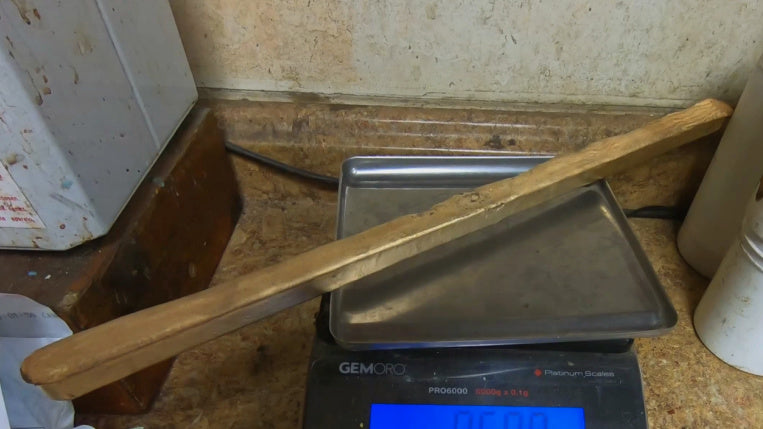
Resulting 14K gold bar used to make the links of the chain.
Gold Wire Stretching Process
The gold bar created in the previous step needs to be stretched and compressed using various automatic rolling mills until it is shaped into a wire of the appropriate gauge to make the links of the chain. On the video, we only show a certain number of passes through the mills in order to limit the video length, but the process is quite time consuming and requires many passes to stretch the wire to proper length (clip 1 [stretching bar], clip 2 [rolling mill], clip 3 [molding wire further]).

The stretching process begins! This is quite time consuming!

Using a rolling mill to round out the edges of the squared wire.

Gold wire is fed through different sized holes to continue the rounding out process.
Rolling and Cutting the Links
Depending on the size of the chain, the gold wire is then tightly wound onto a metal bar of the correct diameter to form a coil. This manual process involves the work of two people and a lot of muscle! A special saw is then used to cut straight through the coil in order to separate the individual links before they are cleaned in a red, ultrasonic jewelry cleaning solution. Using a vise and pliers, the links are then interlocked and closed so that the sawed faces are joined flushed. Thick chains (like the 1-kilo chain on the video) require very thick wire that is more difficult to bend. That is why the process of annealing (heating the metal) is used throughout the video to increase the elasticity of the gold alloy; e.g., when the wound coil is heated with the torch (in this section of the video).
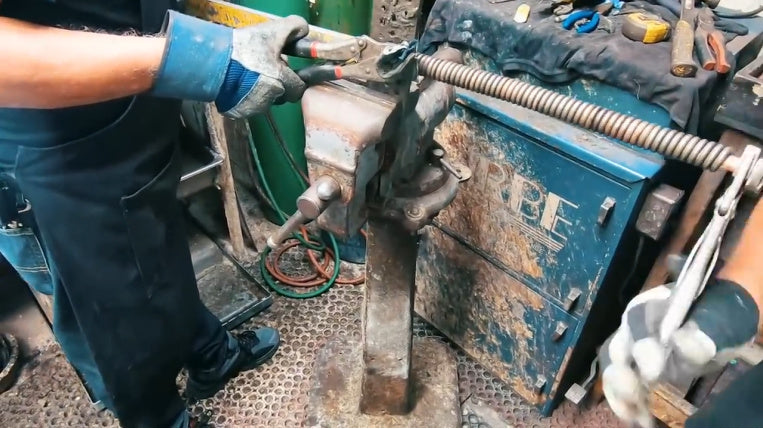
Gold wire rolled into a coil to make the links.

Coil is cut straight through to form the individual links of the chain.
Soldering and Twisting Chain
As each link is attached to one another (as described above), it is soldered at the cut point using gold solder. When all the links of the chain are soldered together, the chain is attached to an industrial twisting machine that twists one end of the chain with the other end held stationary. The objective of this is to align the links in one plane (as opposed to the perpendicular, interlocking links that you see at the end of the previous soldering process). To help twist the links into the classic “flat” position of a Miami Cuban, the chain is annealed with the torch on multiple occasions. It is then cleaned again in the ultrasonic solution.

Soldering the gold links using special, gold solder.
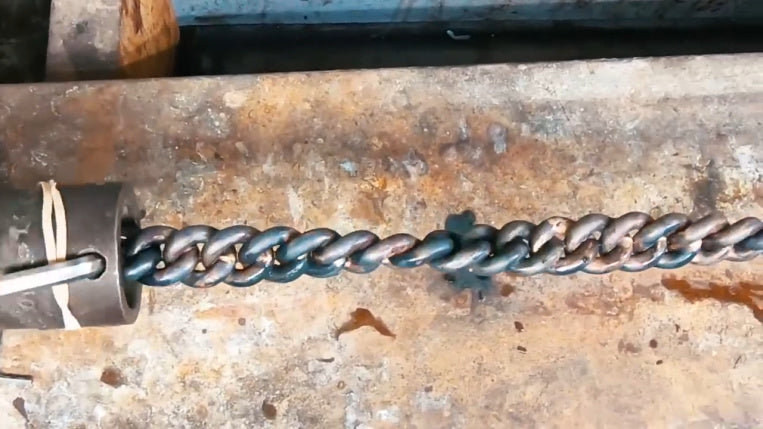
Twisting the soldered links to stack them together in a flat formation.

Gold chain annealed throughout the twisting process.

Resulting chain after twisting and cleaning.
Filing the Links Flat
At the end of the process above, the resulting gold chain is quite heavier than the desired weight (that is, greater than 1 kilogram) because the links are round. This “extra” weight is removed during the filing process, which creates the flat link design a traditional Cuban link chain is known for. Both sides of the chain must be flattened through a manual filing process.
Shellac glue (a resin mixed with alcohol) is first used to affix the chain to a wooden board before filing. A very labor intensive filing process then begins. For the sake of simplicity, we only show a part of the filing process on just one side of the chain. However, both sides must be attached to the board and filed down equally.

Glue is added to board to fix the chain for filing.

Chain is affixed to the board with melted resin (Shellac glue).
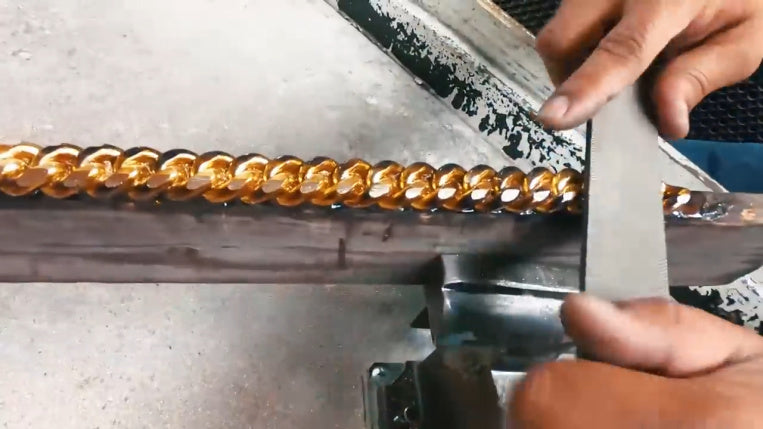
Each side of the chain is then filed down to flatten the links.
Polishing Chain & Final Weigh-in
The final part of the Cuban link making process begins with the polishing and buffing of the chain. We showed sections of this on the video. When this procedure is almost complete, one of the end links is sliced open so that it can be attached to the opposite end of the chain. Once both ends of the chain are attached together and the cut link is welded shut, the surrounding links are polished once more before the entire chain is submerged in a 24K electroplating solution. Please note that most clients (especially those who buy Cuban links in the 10K to 14K quality range) opt to have their chains electroplated. This adds a livelier gold color to the final chain (since 24K gold has the most “impressive” yellowish color of all). Some clients choose not to have their gold Cuban link chains electroplated, especially if they go with 18K gold or higher. The one-kilogram chain on the video was electroplated.
At the end of the video, the gold chain is weighted on a calibrated/certified scale to show that it’s approximately 1000 grams in weight.

Chain is polished and buffed to maximize luster.

End links are attached, soldered and polished.
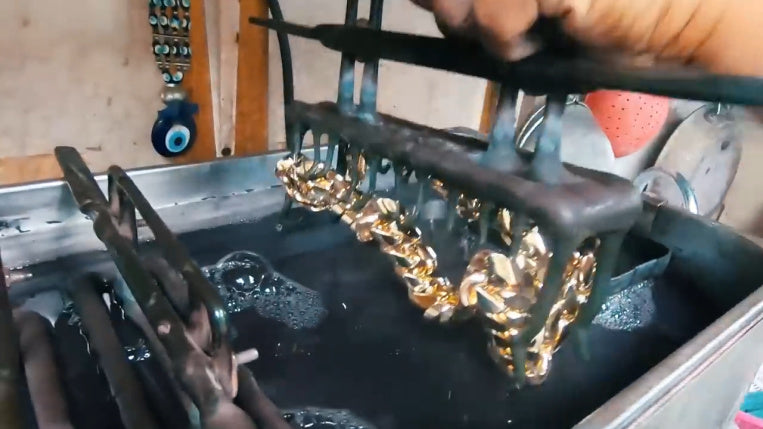
Chain is cleaned one last time in an ultrasonic cleaning machine.
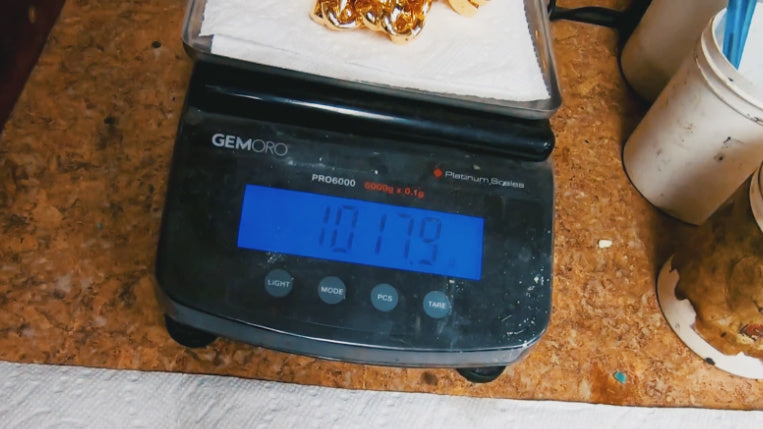
Gold chain is weighted one last time (weight is in grams).
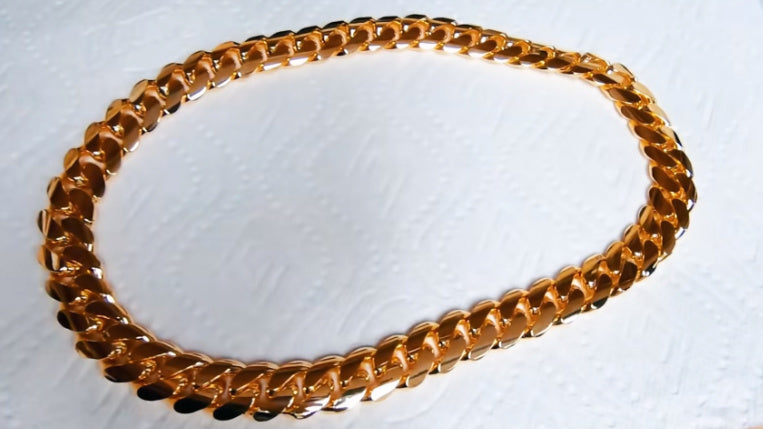
To play around with our Cuban Link Calculator and get real live prices for chains of different lengths, widths and types of gold, click here.
If you want to purchase one of our most popular Cuban link chains, click here.



